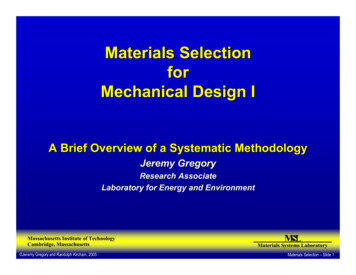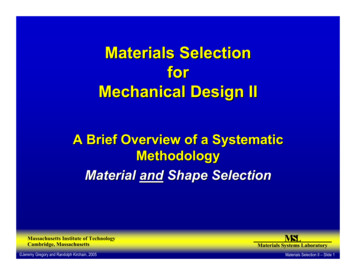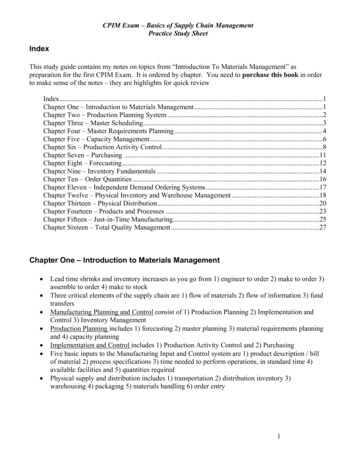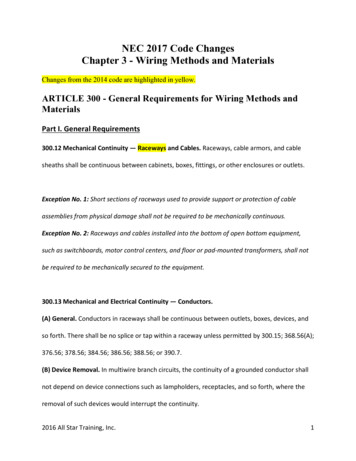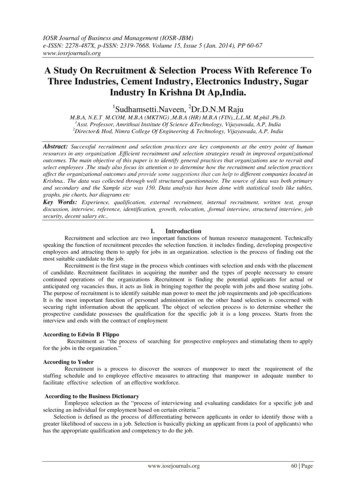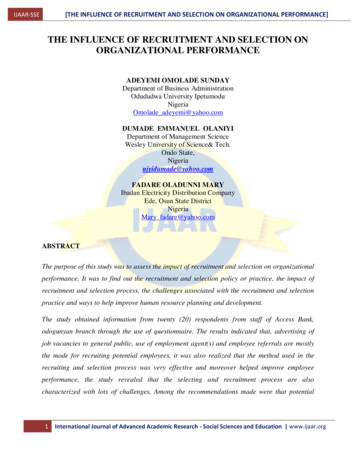
Transcription
Chapter 9THE MATERIALS SELECTIONPROCESSMaterials and Process Selection for Engineering Design: Mahmoud Farag1
Chapter 9: Goal and objectivesThe overall goal of this chapter is to illustrate how systematicselection procedures can be used to select optimum materials andprocesses for a given component.The main objectives are to illustrate how to:1. Analyze material performance requirements for a givenapplication.2. Create alternative solutions, screen them, and then rank the viablecandidates.3. Use quantitative methods in materials selection.4. Incorporate computer methods in the selection process.5. Find reliable sources of material properties.Materials and Process Selection for Engineering Design: Mahmoud Farag2
The nature of the selection processSelecting the optimum combination of material and processcannot be performed at one certain stage in the history of aproject, it should gradually evolve during the different stages ofproduct development.After identifying the function of the component, the followingquestions become important: What are the primary design and material requirements? What are the secondary requirements and are they necessary?Materials and Process Selection for Engineering Design: Mahmoud Farag3
General steps in materials selection1.2.3.4.Analysis of the performance requirements.Development of alternative solutions to the problem.Evaluation of the different solutions.Decision on the optimum solution.Materials and Process Selection for Engineering Design: Mahmoud Farag4
Fig. 9.1 Major stages of design and the related stages of materials selection IStages of DesignStages of Materials SelectionPreliminary and ConceptualDesignAnalysis of material performancerequirementsTranslate marketing ideas intoindustrial design leading to broaddescription of the product: What isit? What does it do? How does it doit? How much should it be?Formulate product specifications,develop various concepts and selectthe optimum conceptDecompose the product intosubassemblies and identify thedifferent parts of each subassembly.Specifying the main function ofeach part and identify their criticalrequirements.Creating alternative material andprocess solutions for the optimumconceptInitial ScreeningUse the critical requirements of eachpart to define the performancerequirements of the material. Startwith all materials available andnarrow down the choices on the basisof the rigid requirements.Materials and Process Selection for Engineering Design: Mahmoud Farag5
Fig. 9.1 Major stages of design and the related stages of materials selection IIStages of DesignConfiguration (Embodiment)DesignDevelop a qualitative sketch of eachpart giving only the order ofmagnitude of the main dimensions butshowing the main features – walls,bosses, ribs, holes, grooves, etcStages of Materials SelectionComparing Alternative SolutionsUse soft material requirements tofurther narrow the field of possiblematerials to a few optimumcandidates.Materials and Process Selection for Engineering Design: Mahmoud Farag6
Fig. 9.1 Major stages of design and the related stages of materials selection IIIStages of DesignStages of Materials SelectionDetail (Parametric ) DesignSelection of Optimum SolutionDetermine the dimensions andfeatures of the parts based on aspecific material and a manufacturingprocess taking into account the designlimitations, the manufacturingprocess, weight concerns, spacelimitations, etc. The cost must now beconsidered in detail.Generation of an alternative detaildesign, which requires selecting adesign based on alternative materialsand evaluation against requirements.Use the optimum materials andmatching manufacturing processesto make detail designs.Compare alternative combinationstaking into account the elements ofcost.Select optimum combination ofdesign-material-manufacturingprocessMaterials and Process Selection for Engineering Design: Mahmoud Farag7
Analysis of material performancerequirementsThe material performance requirements can be divided into 5 broadcategories: Functional requirementsProcessability requirementsCostReliability requirementsResistance to service conditionsMaterials and Process Selection for Engineering Design: Mahmoud Farag8
Creating alternative solutionsHaving specified the material requirements, the rest of the selectionprocess involves the search for the material that would best meetthose requirements.The starting point is the entire range of engineering materials.At this stage, it is essential to open up channels in differentdirections. A steel may be the best material for one designconcept while a plastic is best for a different concept, eventhough the two designs provide similar functions.The importance of this phase is that it creates alternatives withoutmuch regard to their feasibility.Materials and Process Selection for Engineering Design: Mahmoud Farag9
Initial screening of solutions IRigid materials and process requirementsInitial screening of materials can be achieved by first classifying theirperformance requirements into two main categories: Rigid, or go-no-go, requirements. Soft, or relative, requirements.Materials that do not satisfy the rigid requirements are eliminated.For example, metals and alloys are eliminated when selectingmaterials for an electrical insulator.Materials and Process Selection for Engineering Design: Mahmoud Farag10
Initial screening of solutions IICost per unit property methodIn the case of tensile members, the cost of unit strength[(C ρ)/S]can be used for initial screening. Materials with lower costper unit strength are preferable. If an upper limit is set forthe quantity (C ρ)/S, then materials satisfying thiscondition can be identified and used as possible candidatesfor more detailed analysis in the next stage of selection. Table 9.1 gives some formulas for cost per unit propertyunder different loading conditionsMaterials and Process Selection for Engineering Design: Mahmoud Farag11
Initial screening of solutions IIITable 9.1 Formulas for estimating cost per unit propertyCross-section and loading conditionCost per unit strengthSolid cylinder in tension or compressionC /S2/3Solid cylinder in bendingC /S2/3Solid cylinder in torsionC /SSolid cylindrical bar as slender column--1/2Solid rectangle in bendingC /SThin-walled cylindrical pressure vesselC /SMaterials and Process Selection for Engineering Design: Mahmoud FaragCost per unit stiffnessC /E1/2C /E1/2C /GC /E1/21/3C /E--12
Initial screening of solutions IVCase study 9.1-Selecting a beam material for minimum cost IA simply supported beam of rectangular cross section of length1 meter, width 100 mm, and no restriction on the depth issubjected to a load of 20 kN in its middle.The main design requirement is that the beam should not sufferplastic deformation as a result of load application.Select the least expensive material for the beam from Table 9.2.Materials and Process Selection for Engineering Design: Mahmoud Farag13
Initial screening of solutions IVCase study 9.1-Selecting a beam material for minimumcost IITable 9.2 Characteristics of candidate materials for the beamMaterialWorking stress aMPaksiSpecific Relativegravity cost bSteel AISI 1020, normalizedSteel AISI 4140, normalizedAluminum 6061, T6 temperEpoxy 70% glass Cost ofunitstrength0.730.731.692.26a The working stress is computed from yield strength using a factor of safety of 3.b The relative cost per unit weight is based on AISI 1020 steel as unity.Material and processingcosts are included in the relative cost.Materials and Process Selection for Engineering Design: Mahmoud Farag14
Initial screening of solutions IVCase study 9.1-Selecting a beam material for minimumcost IIISolution: Based on Table 9.2 and the appropriate formula fromTable 9.1, the cost of unit strength for the differentmaterials is calculated and the results are given in the lastcolumn of Table 9.2. The results show that steels AISI 1020 and 4140 areequally suitable, while Al 6061 and epoxy - glass are moreexpensive.Materials and Process Selection for Engineering Design: Mahmoud Farag15
Ashby’smethodfor initialscreeningIMaterials and Process Selection for Engineering Design: Mahmoud Farag16
Ashby’smethodfor initialscreeningIIMaterials and Process Selection for Engineering Design: Mahmoud Farag17
Comparing and ranking alternatives IWeighted properties method IIn this method each material requirement is assigned a certainweight, depending on its importance.A weighted property value is obtained by multiplying the scaledvalue of the property by the weighting factor (α).The weighted property values of each material are then summed togive a performance index (γ). The material with the highestperformance index (γ) is optimum for the application.B scaled property numerical value of property x um value in the listMaterials and Process Selection for Engineering Design: Mahmoud Farag18
Comparing and ranking alternatives IWeighted properties method IIFor cost, corrosion loss, etc., a lower value is more desirable and thelowest value is rated as 100B scaled property minimum value in the list x al value of propertynMaterial performance index γ Σ Bi αii 1where i is summed over all the n relevant properties.Materials and Process Selection for Engineering Design: Mahmoud Farag19
Comparing and ranking alternatives IThe Digital Logic MethodTable 9.3 Determination of the relative importance of goals using the digital logic methodGoals12345Number of positive decisions N n(n -1)/212345678101091011001010110001Total number of positive decisions01Materials and Process Selection for Engineering Design: Mahmoud icient 0.30.20.10.20.2 1.020
Comparing and ranking alternatives ITaking cost into considerationCost can be considered as one of the properties and given a weightingfactor or considered separately as a modifier to the materialperformance index (γ).In the cases where the material is used for space filling, cost can beintroduced on per unit volume basis. A figure of merit (M) for thematerial can then be defined as:M γ/(C ρ)C total cost of the material per unit weight (stock, processing,finishing, .etc)ρ density of the material.Materials and Process Selection for Engineering Design: Mahmoud Farag21
Case study 9.2-Selecting the optimum material for acryogenic storage tankMaterials requirements: used in cryogenic applications for liquefied nitrogen gas) mustnot suffer ductile-brittle transition at -196oC Using stronger material gives thinner walls, which means a lightertank, lower cool down losses, and easier to weld. Lower specific gravity gives lighter tank. Lower specific heat reduces cool down losses. Lower thermal expansion coefficient reduces thermal stresse. Lower thermal conductivity reduces heat losses. The cost of material and processing will be used as a modifier tothe material performance index.Materials and Process Selection for Engineering Design: Mahmoud Farag22
Table 9.4 Application of digital logic method tocryogenic tank problemPropertyDecision number123456Toughness111111Yield strength0Young’s modulusDensity0Specific 00131101217181110101600Materials and Process Selection for Engineering Design: Mahmoud Farag192011002100123
Table 9.5 Weighting factors for cryogenic tankPropertyPositive decisionsWeighting factorToughness60.28Yield strength30.14Young’s 10.05Specific heat10.05Total211.00Materials and Process Selection for Engineering Design: Mahmoud Farag24
Table 9.6 Properties of candidate materials for cryogenic tankMaterial1234567Toughnessindex ThermalexpansionThermalconductivitySpecificheat dbc(MPa)Al 2014-T675.542074.22.821.40.370.16Al 5052-O9591702.6822.10.330.16SS 030.08Ti-6Al-4V1798751124.439.40.0160.09Inconel 319.90.290.06SS 3103/4HaToughness index, TI, is based on UTS, yield strength YS, and ductility e, at-196 oC (-321.8 oF)TI (UTS YS)e/2bThermal expansion coefficient is given in 10-6/ oC. The values are averaged between RT and 196 oC.cThermal conductivity is given in cal/cm2/cm/ oC /s.dSpecific heat is given in cal/g/oC. The values are averaged between RT and -196 oC.Materials and Process Selection for Engineering Design: Mahmoud Farag25
Table 9.7 Scaled values of properties and performance indexMaterialScaled properties1234Performanceindex (γ)567Al 2014-T610303496444.33842.2Al 5052-O12632100434.83840.1SS 301-FH100100873456407570.9SS 759.8Inconel .9Materials and Process Selection for Engineering Design: Mahmoud Farag26
Table 9.8 Cost, figure of merit, and ranking of candidate materialsMaterialRelative costCost of unitstrengthx100PerformanceindexFigure ofmeritRankaAl 2014-T610.6742.262.992Al 5052-O1.053.0940.112.986SS 301-FH1.40.8170.987.531SS 4Inconel ials and Process Selection for Engineering Design: Mahmoud Farag27
Comparing and ranking alternatives IILimits on properties method IThe performance requirements are divided into three categories: lower limit properties; upper limit properties; target value properties.The limits can be used for eliminating unsuitable materials from adata bank.After the elimination stage, the limits on properties method can thenbe used to optimize the selection from among the remainingmaterials.Materials and Process Selection for Engineering Design: Mahmoud Farag28
selection procedures can be used to select optimum materials and processes for a given component. The main objectives are to illustrate how to: 1. Analyze material performance requirements for a given application. 2. Create alternative solutions, screen them, and then rank the viable candidates. 3. Use quantitative methods in materials selection. 4. Incorporate computer methods in the selection process.File Size: 825KBPage Count: 54

